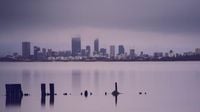As Australia grapples with the relentless impacts of climate change, a recent analysis by the Climate Council has unveiled alarming statistics regarding the vulnerability of properties across the nation. The report highlights that over two million properties are currently at moderate to high risk from worsening extreme weather events driven by climate pollution. This situation is particularly dire in certain electorates, where the risks of catastrophic damage are escalating due to climate inaction.
The analysis identifies the top ten electorates most at risk, revealing a stark picture of how climate change is already affecting communities. These areas, which include Richmond in New South Wales and Nicholls in Victoria, are grappling with significant threats from flooding, bushfires, and other extreme weather events.
Richmond, New South Wales, stands out with 31,564 properties—28.9% of the total—classified as high risk. The main threats here include riverine flooding, surface flooding, and bushfires. The report indicates a 4% increase in the average risk of damage from climate extremes from 1990 to 2025. Notably, regions like Tweed, Byron, and Ballina are also at risk of tropical cyclones, with Tweed and Ballina facing a higher flood risk than almost any other local government area in New South Wales, except for Clarence Valley. If climate pollution continues at high levels, the average risk of damage in Richmond could increase by a staggering 158% by the end of the century.
In Nicholls, Victoria, the situation is similarly troubling. Here, 26,055 properties (25.5%) are already deemed high risk, primarily due to riverine flooding, surface water flooding, and extreme winds. The average risk of damage from climate extremes has surged by 20.5% since 1990, with projections suggesting an additional 8.4% increase by century's end. Communities in Nicholls have already experienced the devastating effects of climate-driven disasters, with towns like Echuca and Shepparton suffering from severe flooding in 2022.
Moving to South Australia, the Mayo electorate, which encompasses the picturesque Fleurieu Peninsula and Kangaroo Island, faces its own challenges. Approximately 20,177 properties, or 17.5%, are at high risk, with bushfires being the primary concern, followed by riverine and surface flooding. Since 1990, the average risk of damage has risen by 20.8%, and projections indicate this could nearly double (up 83%) by the end of the century.
Brisbane, Queensland, also finds itself at significant risk. The electorate, which includes the Central Business District and surrounding areas, has 18,978 properties (12.7%) classified as high risk. The main threats include surface flooding, riverine flooding, and coastal inundation. The average risk of damage has grown by 36.3% since 1990, with a projected increase of 64.8% by 2100. The 2022 floods impacted at least 179 suburbs across the Greater Brisbane area, highlighting the urgent need for action.
Page, New South Wales, is another area of concern, with 18,636 properties (16.9%) at high risk from riverine floods, bushfires, and surface flooding. The average risk of damage has increased by 7.3% since 1990, and projections suggest a 69.6% rise in risk by 2100. The local government area of Clarence Valley has been particularly hard hit, with historical disaster recovery funding indicating its vulnerability.
Maranoa in Queensland, which stretches from Brisbane's outskirts to the Northern Territory and South Australian borders, is home to 18,499 high-risk properties (13.7%). The electorate has seen significant bushfire damage, with the 2023-24 season being particularly devastating. The average risk of damage has increased by 10.4%, with projections indicating a 42.3% rise by century's end.
Robertson, New South Wales, is facing similar challenges, with 14,063 properties (14.72%) at high risk. The primary threats include bushfires, riverine flooding, and surface flooding, with an estimated 26.9% rise in average risk since 1990. Projections suggest that risk could more than double (132.6%) by 2100.
In Western Australia, the newly formed Bullwinkel electorate has 12,719 properties (15.6%) at high risk from bushfires, riverine flooding, and surface flooding. The average risk of damage has increased by 36.8% since 1990, and projections indicate a staggering 313.7% increase in risk by the end of the century.
Dobell, New South Wales, which includes popular tourist spots like Long Jetty and The Entrance, has 12,569 properties (13.88%) at high risk, primarily from bushfires and flooding. The average risk has increased by 22.2% since 1990, with projections indicating a 144.5% increase by century's end.
Lastly, the Hunter electorate in New South Wales, which includes the town of Singleton—historically prone to flooding—has 12,363 properties (12.84%) at high risk. The average risk of damage has grown by 32.52% since 1990, with projections suggesting an 89.2% increase by the end of the century.
The Climate Council's report underscores the urgent need for action to mitigate climate change and its impacts on Australian communities. With over two million homes and businesses facing high or moderate risk today, the time for decisive action is now. As climate pollution continues to drive extreme weather events, the consequences for these electorates could be catastrophic if significant measures are not taken to reduce emissions and enhance resilience.




